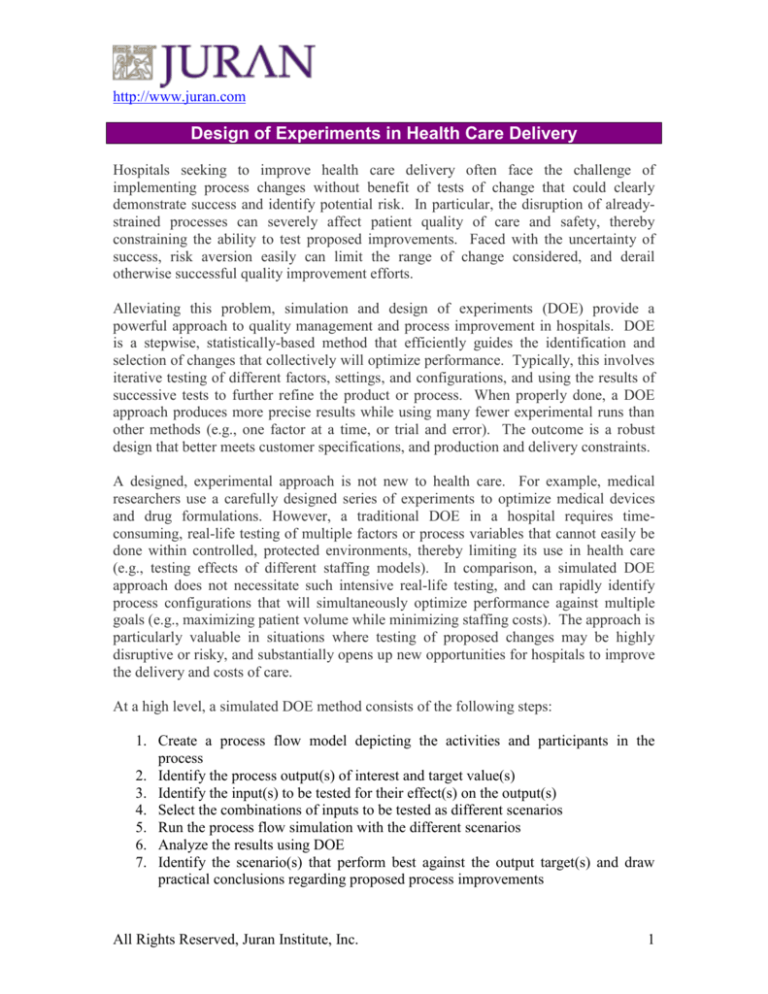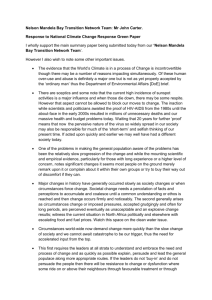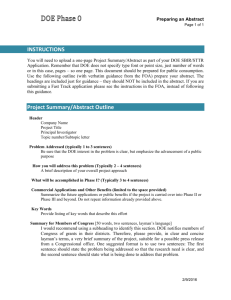
http://www.juran.com
Design of Experiments in Health Care Delivery
Hospitals seeking to improve health care delivery often face the challenge of
implementing process changes without benefit of tests of change that could clearly
demonstrate success and identify potential risk. In particular, the disruption of alreadystrained processes can severely affect patient quality of care and safety, thereby
constraining the ability to test proposed improvements. Faced with the uncertainty of
success, risk aversion easily can limit the range of change considered, and derail
otherwise successful quality improvement efforts.
Alleviating this problem, simulation and design of experiments (DOE) provide a
powerful approach to quality management and process improvement in hospitals. DOE
is a stepwise, statistically-based method that efficiently guides the identification and
selection of changes that collectively will optimize performance. Typically, this involves
iterative testing of different factors, settings, and configurations, and using the results of
successive tests to further refine the product or process. When properly done, a DOE
approach produces more precise results while using many fewer experimental runs than
other methods (e.g., one factor at a time, or trial and error). The outcome is a robust
design that better meets customer specifications, and production and delivery constraints.
A designed, experimental approach is not new to health care. For example, medical
researchers use a carefully designed series of experiments to optimize medical devices
and drug formulations. However, a traditional DOE in a hospital requires timeconsuming, real-life testing of multiple factors or process variables that cannot easily be
done within controlled, protected environments, thereby limiting its use in health care
(e.g., testing effects of different staffing models). In comparison, a simulated DOE
approach does not necessitate such intensive real-life testing, and can rapidly identify
process configurations that will simultaneously optimize performance against multiple
goals (e.g., maximizing patient volume while minimizing staffing costs). The approach is
particularly valuable in situations where testing of proposed changes may be highly
disruptive or risky, and substantially opens up new opportunities for hospitals to improve
the delivery and costs of care.
At a high level, a simulated DOE method consists of the following steps:
1. Create a process flow model depicting the activities and participants in the
process
2. Identify the process output(s) of interest and target value(s)
3. Identify the input(s) to be tested for their effect(s) on the output(s)
4. Select the combinations of inputs to be tested as different scenarios
5. Run the process flow simulation with the different scenarios
6. Analyze the results using DOE
7. Identify the scenario(s) that perform best against the output target(s) and draw
practical conclusions regarding proposed process improvements
All Rights Reserved, Juran Institute, Inc.
1
http://www.juran.com
Several iterations may be needed to refine and test scenarios before converging on a final
configuration or small number of alternatives to test in actual operations.
Below are examples of questions that this approach of simulated DOE could address in a
health care delivery setting.
Staffing
How many Emergency Department RNs are needed to maintain patient
average length of stay around 120 minutes and simultaneously minimize
labor costs across a range of anticipated patient arrival rates?
What mix of clerical and clinical resource skill levels optimize emergency
department door-to-doc time?
Will the addition of one radiologist be worth the extra cost in terms of
turnaround time? Should any additional radiologist be dedicated to the
emergency department?
Bed Allocation
How many in-patient beds of different types (e.g., Medical/Surgical, Adult
Intensive Care (ICU), Burn ICU) will yield an overall 75% utilization?
Would patient flow improve if one of the emergency department triage
rooms were converted into an exam room?
Emergency Department Flow
On what days of the week should a Fast Track process be in operation to
minimize patient waiting room time, and should RN and physician
resources be dedicated to the Fast Track process when it is in operation?
How would partial conversion of incoming patient waiting room space
into a treated patient holding area impact exam room utilization and rate of
patients leaving without being seen? Should such a holding area only
operate under high patient volume?
Several advantages are evident in the application of simulated DOE to health care
delivery.
Predictions are possible for situations that do not necessarily exist. In
modeling emergency department staffing, for example, high-volume surge
arrival rates need not be experienced in real life (although any
All Rights Reserved, Juran Institute, Inc.
2
http://www.juran.com
extrapolation outside the bounds of actual observations must be done with
caution).
Solutions that would be very difficult, disruptive or risky to test under real
life conditions easily can be tested. For example, it is difficult or
impossible to adjust the arrival rates of patients.
Interactions can be identified and taken into consideration when making
process improvements. The DOE approach specifically allows for the
testing of both main effects and interactions. For example, the benefit of
adding nurses may be greater at higher patient arrival rates.
Many different configurations can be tested in a very short period of time.
Once the initial process flow model is created, scenarios are relatively
straightforward to set up and test. Answers that normally would take
many days or weeks to obtain can be acquired in a matter of hours.
There are several downsides to this approach. First, building a discrete event simulation
is tedious, time-consuming, and often requires data that may not readily be available.
The data can be acquired with some planning, however, and once a model is built it can
be put to many uses. Second, neither simulation nor DOE are widely used in health care,
and the approach may be treated with suspicion. To alleviate this, engage the assistance
of experts, and always pilot changes in a protected environment before fully
implementing. Despite these drawbacks, the potential benefits warrant a closer look at
simulated DOE for improving hospital process improvement.
Conclusions
The combination of simulation and DOE provides a powerful approach to the design,
testing, and improvement of hospital processes. Although DOE frequently is used in
other industries, it remains underutilized in health care. Integrating DOE with simulation
helps address some of the perceived problems in applying DOE within the constraints of
health care delivery settings. Although any configuration identified by DOE should still
be tested in real life before final implementation, there is much greater confidence in the
solution than without any testing, and much less disruption, time expenditure and risk
than with less structured and potentially statistically unsound methods.
All Rights Reserved, Juran Institute, Inc.
3








